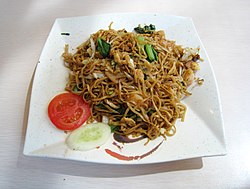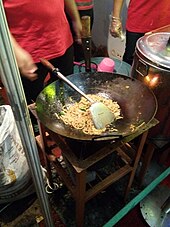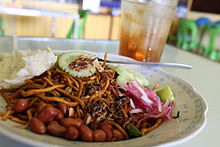


Mie goreng in a restaurant in Jakarta
| |
| Alternative names | Bakmi goreng, Mi goreng |
|---|---|
| Type | Noodle |
| Course | Main course |
| Place of origin | Indonesia[1] |
| Region or state | Nationwide |
| Serving temperature | Hot |
| Main ingredients | Fried noodles with chicken, meat or prawn |
Mie goreng (Indonesian: mi goreng; meaning "fried noodles"[2]), also known as bakmi goreng,[3] is an Indonesian stir-fried noodle dish. It is made with thin yellow noodles stir-fried in cooking oil with garlic, onionorshallots, fried prawn, chicken, beef, or sliced bakso (meatballs), chili, Chinese cabbage, cabbages, tomatoes, egg, and other vegetables. Ubiquitous in Indonesia, it is sold by food vendors from street hawkers (warungs) to high-end restaurants.

In Indonesia, where mi goreng is one of the most widespread simple dishes, the dish's origin is associated with Chinese Indonesian cuisine.[1] Chinese influences are evident in Indonesian food such as bakmi, mi ayam, pangsit, bakso, lumpia, kwetiau goreng, and mi goreng.[4] The dish is derived from Chinese chow mein and is believed to have been introduced by Chinese immigrantsinIndonesia. Despite being influenced by Chinese cuisine, mi goreng in Indonesia has a definite Indonesian taste and has been heavily integrated into Indonesian cuisine,[5] through, for example, the application of sweet soy sauce that adds mild sweetness,[6] a sprinkle of fried shallots, and spicy sambal. Pork and lard are eschewed in favour of shrimp, chicken, or beef to cater to the Muslim majority.
Mi goreng is traditionally made with yellow wheat noodles, stir-fried with chopped shallots, onion, and garlic with soy sauce seasoning, egg, vegetables, chicken, meat, or seafood. However, other versions might use dried instant noodles instead of fresh yellow wheat noodles. A common practice in Indonesia is the inclusion of powdered instant noodle seasonings, along with eggs and vegetables. Authentic mi goreng uses fresh ingredients and spices; however, bottled instant spice paste might be used for practical reasons.[7]
The almost identical recipe is often used to create other dishes. For example, bihun goreng is made by replacing yellow wheat noodles with bihun (rice vermicelli), while kwetiau goreng uses kwetiau (thick flat rice noodles) instead.

Some mi goreng variants exist. In Indonesia, mi goreng variants are usually named after the ingredients, while some might be named after the region of origin.

Indonesians tend to name similar foreign dishes as mi goreng, for example in Indonesia, chow mein is often called mi goreng Cina and yakisoba is called mi goreng Jepang.
{{cite news}}: CS1 maint: unfit URL (link)
|
| |||||||||||||||||||||||||||||
|---|---|---|---|---|---|---|---|---|---|---|---|---|---|---|---|---|---|---|---|---|---|---|---|---|---|---|---|---|---|
| Variants |
| ||||||||||||||||||||||||||||
| Dishes |
| ||||||||||||||||||||||||||||
| Instant noodle brands |
| ||||||||||||||||||||||||||||
| List articles |
| ||||||||||||||||||||||||||||
| See also |
| ||||||||||||||||||||||||||||
| |||||||||||||||||||||||||||||